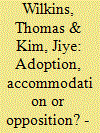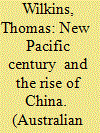|
|
|
Sort Order |
|
|
|
Items / Page
|
|
|
|
|
|
|
| Srl | Item |
| 1 |
ID:
189245


|
|
|
|
|
| Summary/Abstract |
This article examines the new prominence accorded to the “Indo-Pacific” (IP) concept in the strategic narratives championed by the US and its closest allies, (Japan and Australia), and then juxtaposes this with the responses of other key regional powers. To this purpose, Part I distils a concise conceptual model encompassing three interlocking facets – mental maps, political/ideological drivers, and visions of regional order – designed to structure the following empirical analyses. Part II then accesses this model to reveal how these facets are reflected in the discursive and policy-making practices of the US and its close allies, as embodied in their (combined) regional strategies. Next, Part III considers how a cross-section of major states in the region – India, South Korea, and China - have responded to this enterprise, to determine the degree to which they have adopted, accommodated or opposed the IP concept, or otherwise propose national alternatives to the US-centered project. It concludes that the IP concept is not simply an objective geopolitical descriptor, but rather a controversial and contested discursive field, subject to multiple interpretations. Such a polarizing concept will likely contribute to further sharpening of strategic mistrust and geopolitical competition amongst the region’s major powers.
|
|
|
|
|
|
|
|
|
|
|
|
|
|
|
|
| 2 |
ID:
117834


|
|
|
|
|
| Publication |
2012.
|
| Summary/Abstract |
This article provides a working taxonomy of the concept of 'alignment' in the discipline of International Relations (IR); a heretofore major deficiency in the otherwise abundant literature on alliance/alignment. It further contends that the label 'alliance' is commonly employed reflexively and unreflectively, where in fact the term 'alignment' would be a superior and more accurate descriptor. This contention is buttressed by empirical developments in international politics. The article makes the case that the contemporary security environment is characterised by multiple forms of 'alignment', not just alliances, in their many guises. In addition, we can identify 'coalitions', 'security communities', and 'strategic partnerships'; all distinctly different from the conventional 'alliance' archetype. It concludes that a change in our thinking about defining and conceptualising alignment and alliance is required to bring disciplinary work closer in line with the paradigmatic shift that is occurring in contemporary international politics.
|
|
|
|
|
|
|
|
|
|
|
|
|
|
|
|
| 3 |
ID:
187210


|
|
|
|
|
| Summary/Abstract |
A reassessment the nature of “alliances” and “alignments” since the end of the Cold War, both practically and conceptually, is long overdue. Treaty alliances have become partially obsolescent as new models of security cooperation, such as the ‘strategic partnership’, and other “minilateral” configurations, have emerged as preferred instruments of alignment. The evolving nature of alliance and alignment is nowhere better illustrated than in the metamorphosis of the venerable Hub-and-Spokes US alliance system in the Indo-Pacific. This article captures the changes occurring in the US alliance system from both a macro-level (structural) standpoint, before proceeding to the micro-level to evaluate individual alliance/partnership dyads to illustrate the complexion of the hub-and-spokes “plus” configuration of today. It argues that we are witnessing is a “reshuffling of the deck” in terms of traditional treaty allies – with Japan and Australia now forming the “core” of the system, with South Korea effectively confined as a “single-issue” alliance focused on the peninsula, and with Thailand and the Philippines (arguably) becoming increasingly “peripheral”. But even as the original treaty-system contracts, Washington is seeking to “network” the original model through the acquisition of non-treaty strategic partnerships with key states such as India, Singapore, (and, more circumspectly – Taiwan), whilst also welcoming European engagement. This networking strategy is also designed to achieve second and third order effects through incentivisation of direct “spoke-to-spoke” security cooperation and through the concentration of allies/partners into minilateral formations. The resultant reconfiguration might be dubbed a Hub-and-Spokes “plus” model.
|
|
|
|
|
|
|
|
|
|
|
|
|
|
|
|
| 4 |
ID:
098167


|
|
|
|
|
| Publication |
2010.
|
| Summary/Abstract |
The re-emergence of the 'Pacific Century', or 'Asia-Pacific Century', discourse centred on the rise of Chinese power raises important questions in the discipline of international relations (IR). These questions relate to the conceptualisation of the Pacific Century discourse, its application to the contemporary empirical case, and its relationship and amenability to IR theories. In order to address these questions, the article subjects the concept of a 'Pacific Century' to critical analysis through the synergy of three pertinent 'debates'. First, it creates a novel analytical framework to define and codify the parameters of the Pacific Century debate; a discourse that has until now remained diffuse and inchoate. Second, it engages with the present 'great debate' in IR between the traditional/rationalist and critical/reflectivist approaches, applying them in juxtaposition to the notion of a 'new' Pacific Century, led by China. Thirdly, then, the article speaks to the 'rising China' debate, which currently captivates commentators both in academic and policy-making circles. The article explores how the 'Pacific Century' concept is a compound of both ideational and material factors: it is at once both a political/ideological project and a reified intellectual frame of reference. Through this multidimensional analysis, the article aims to shape the re-emerging debate on the Pacific Century, affirm the enduring value of the term, and demonstrate the efficacy of IR theories in deconstructing conceptual problems.
|
|
|
|
|
|
|
|
|
|
|
|
|
|
|
|
|
|
|
|
|